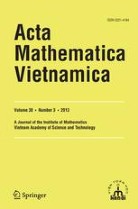
Acta Mathematica Vietnamica
- Volume 50
- Volume 49
- Volume 48
- Volume 47
- Volume 46
- Volume 45
- Volume 44
- Volume 43
- Volume 42
- Volume 41
- Volume 40
- Volume 39
- Volume 38
- Volume 37
- Volume 36
- Volume 35
- Volume 34
- Volume 33
- Volume 32
- Volume 31
- Volume 30
- Volume 29
- Volume 28
- Volume 27
- Volume 26
- Volume 25
- Volume 24
- Volume 23
- Volume 22
- Volume 21
- Volume 20
- Volume 19
- Volume 18
- Volume 17
- Volume 16
- Volume 15
- Volume 14
- Volume 13
- Volume 12
- Volume 11
- Volume 10
- Volume 9
- Volume 8
- Volume 7
- Volume 6
- Volume 5
- Volume 4
- Volume 3
- Volume 2
- Volume 1
An Overview of Motivic Homotopy Theory
Marc Levine
Abstract
Motivic homotopy theory was constructed by Morel and Voevodsky in the 1990s. It led to such striking applications as the solution of the Milnor conjecture and the Bloch-Kato conjecture on the Galois symbol. Since then the theory has turned to a systematic study of its basic invariants and structures, as well as providing numerous new applications. Morel, Cisinski-Déglise, and Röndigs-Østvær have described the relation of the motivic stable homotopy category to Voevodskys triangulated category of motives. Morel’s computation of the endomorphism of the sphere spectrum points out a close relationship to quadratic forms, and has given rise to the construction of interesting new oriented cycle theories. Asok and Fasel have applied computations of unstable motivic homotopy groups to stability problems for algebraic vector bundles. Isaksen and others have computed motivic versions of Adams-Novikov and Adams spectral sequences, and used this information to improve known computations of these spectral sequences in classical homotopy theory. We will discuss the basic ideas going into the construction of motivic homotopy theory and some of these results and applications.


